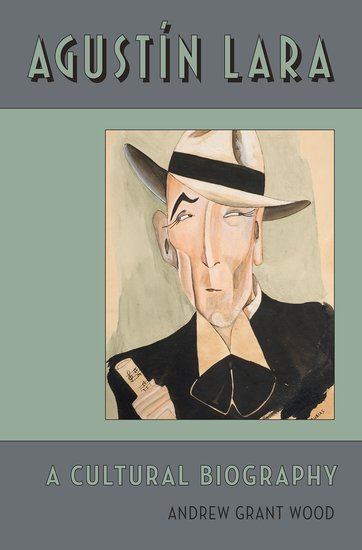
Agustín Lara: A Cultural Biography by Andrew Grant Wood
Book Review by León F. García Corona
Agustín Lara is arguably the most prominent musical figure in early to mid twentieth-century Mexico City. Often compared with Irving Berlin and George Gershwin, his career touched on almost every major media industry including radio, film, recorded sound, and theatrical plays (cabaret productions). His prolific career, celebrity lifestyle and international success placed him squarely at the center of Mexico’s cultural industry.
Lara’s life and works have been the subject of several publications, the large majority in Spanish by novelists, poets, and bolero aficionados (see, for example, Taibo 1984 and 1985, and Aura 1990). Many of these authors employ a distinctly hagiographic approach. None contemplates Lara’s life and work from a well-rounded perspective weaving together historical, social, economic, political and cultural themes. Wood’s goal in Agustín Lara: A Cultural Biography is precisely to fill this void, which he accomplishes.
Wood follows Lara’s life and career chronologically, exploring the connections between socio-political events and the cultural production of the time. It begins by setting the musical and geographical scene with background information about the bolero and danzón, Mexico City’s urban development, and early accounts of Lara’s life. Wood’s social and historical approach guides the book as he explores the connections between Lara’s music and its socio-cultural aspects.
Wood also contextualizes Lara’s life and career within global and local politics. His discussion about the influence of the U.S. Department of State, the Office of the Coordinator of Inter-American Affairs, and powerful executives from NBC and CBS shed light on the ideologies and political interests that played important roles in the celebrated “golden age” of Mexican cultural industries and its connections with geo-political events (122).
Overall, the book is a solid first step toward a scholarly approach to Lara’s life and work. It presents an engaging narrative that will appeal to a general audience. Wood’s extensive research, however, is not placed within theoretical frameworks that would aid in understanding Lara’s life and times. In his discussion of the song “Veracruz,” for example, Wood focuses on what it meant for Lara to be associated with the place itself, initiating an exploration of issues of authenticity and symbolic capital but failing incorporate theoretical concepts that would have provided much needed cultural insight while engaging scholars from other disciplines (42). When cited, important and relevant theoretical concepts such as Raymond Williams’ “structure of feeling” are mentioned only in passing (158).
The book is supported by an impressive amount of archival research with many of the sources in Spanish, but it includes at least a dozen mistranslations of simple song titles such as “Un beso a solas,” translated as “A Kiss for the Single Girls” (128) and “Puedes irte de mí,” translated as “Could You Come to Me?” (129). Similarly, the song “Mía nomás,” which is a trickier translation for non-native speakers, means “Only Mine,” not “Mine No More” (164). These are minor details, but there are enough of them to call into question the author’s interpretations and his ability to translate linguistic and cultural nuances.
The book includes many powerful visuals such as posters, advertisements, photographs of Mexico City in the 1950s, paintings, caricatures and newspaper clips. Except for a brief explanation of the cinquillo, however, the book lacks musical examples and analysis that music specialists have come to expect from most of the other books in this Oxford series (Currents in Latin American and Iberian Music).
Wood’s book is well suited to anyone interested in popular music in twentieth-century Mexico. He skillfully negotiates historical material, iconographic analysis, urban legends, and myths surrounding the composer, weaving all into an engaging narrative. Music scholars will find valuable new information informed by a variety of disciplines (musicology, Latin American studies, and media studies, among others). The book is a long overdue English-language biography of Lara, and it should be a welcome addition to the library of anyone interested in the history of sentimental music in Latin America.
Reference:
Wood, Andrew Grant. 2014. Agustín Lara: A Cultural Biography. New York: Oxford University Press.